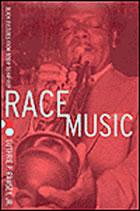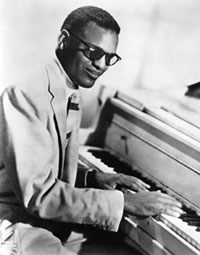
The work of late Eileen Southern and Amiri Baraka (Leroi Jones) are the twin pillars of Black Music scholarship in the United States. Trained as a musicologist, Southern was best known for her classic study The Music of Black Americans: A History. Baraka, of course, is the author of the groundbreaking Blues People, a book that 40 years after its publication is generally recognized as the foundation of African-American Cultural Studies. Whereas Southern may have been most concerned with the music, Baraka was most concerned with the music’s political connotations, specifically in the context of black cultural nationalism in the 1960s. It is this seeming divide that Guthrie P. Ramsey largely recovers in his book Race Music: Black Cultures from Bebop to Hip-Hop. An ambitious effort, Ramsey’s Race Music is an interdisciplinary explosion, finding grounding in the amorphous, theoretical, and familial aspects of black life and culture, or what he refers to as the “Afro-modernist” impulse.
“For African Americans,” Ramsey argues, “the thrust of Afro-modernism has always been…defined primarily within sociopolitical arena: as the quest for liberation, freedom, and literacy as well as the seeking of upward mobility and enlarged possibilities within the American capitalist system” (106). Given these desires African-Americans attached quite a bit of importance to forms of black expressive culture that entered into the mainstream of American culture in the early decades of the 20th century. Black literature, art, and music were perceived as vehicles to counteract racist constructs of black culture and identity emanating from popular science journals, the burgeoning film industry and the advertising industry. Many black elites, most notably W.E.B. Du Bois, understood this as putting forth the best “face” of the race. Ramsey’s use of the post-World War II period as a point of entry into his study is useful because the war provided an urgency to black political demands for fair treatment and also marks a definitive break—generationally, culturally, aesthetically, socially, and geographically—from the sanctioned face of black expressive culture in the 20th century, at least as forwarded by black cultural gatekeepers.
Specifically Ramsey links Afro-modernism to the “heady momentum of sociopolitical progress during the first half of the twentieth century, and the changing sense of what constituted African American culture (and even American culture generally speaking) at the postwar moment” (28). Echoing the oft-cited work of Robin D.G. Kelley and Eric Lott, Ramsey locates a dramatic tension in the post-world war II period. Instead of privileging the work of be-bop artists, as Kelley and Lott do in their seminal essays, Ramsey suggests that the musical styles of mid-century blues figures like Louis Jordan, Cootie Williams and Dinah Washington—styles that would have been targeted and disparaged by some before the war—became central tenets of the developing Afro-modern world. For example, Ramsey sees a recording like “It’s Just the Blues” (1945) by the Four Jumps of Jive as “drenched in Afro-modernist sensibilities. The recording codified a specific moment or urbanity for African Americans. Even the ‘commercialism’ of the piece is suggestive of the aggressively new economic clout of African Americans, particularly those who lived in the urban north” (51). The song’s “happy-go-lucky” reflected a sense among some African-Anmerican artists in the era that their music was worthy enough to be freely shared beyond segregated black communities and that they could sustain themselves economically in the process.
Though Ramsey’s definition of Afro-modernism fits into the interpretive framework of Baraka’s Blues People, Ramsey deftly roots this impulse within the intimacy of black family life. Thus Race Music begins with Ramsey’s discussion of the role of music in his family. As he writes in opening chapter, the autobiographical impulse throughout Race Music, “brings into high relief, some of the theoretical and intellectual points that I will explore throughout the book. As an African American scholar and musician, I believe there is value in exploring the historical grounding of my own musical profile and revealing this to readers” (4). As such, the chapter’s title, “Daddy’s Second Line”—a reference to the death of Ramsey’s father and New Orleans styled funeral rituals—takes on an added significance. Ramsey’s recollection of his father’s funeral (occurring at a time when he was finishing his dissertation) and the centrality of music in his family’s collective mourning process comprise what he refers to as “community theaters”—“sites of cultural memory” that “include but are not limited to cinema, family narratives and histories, the church, the social dance, the nightclub, the skating rink, and even literature” (4). In this regard, Ramsey’s work owes a great deal to that of early Birmingham School cultural theorists like Raymond Williams, who found value in the study of everyday life. While so much of African-American Cultural Studies has focused on the “everyday” spectacle—think here of virtually every scholarly study of hip-hop music and culture—Ramsey brings his analysis back to the more mundane aspects of everyday black life. In other words how do black people and black families use black music to cope with the everyday realities of black life in the United States?

Like the industry term “race records,” which supposedly marked racial segregation in American listening practices, Ramsey’s Race Music privileges practices in which the black masses used the very logic of racial segregation to create moments of catharsis, recovery, and pleasure. Not simply relying on his own cultural memories, Ramsey devotes an entire chapter to the community theater of his extended family. For example, a song like Ray Charles’s “(Night Time Is) The Right Time” can be read as a metaphor for the ways that some blacks used late night leisure spaces—dancehalls, theaters, after-hours clubs, and various other “chitlin’ circuit” entities—as a means of recovering their humanity in the face of arduous and debilitating 60-hour work weeks. The ability of these leisure seekers to transcend their daily routines by finding some semblance of freedom on the dancefloor or listening to the riffs of an organ-sax R&B combo is an example of the kinds of catharsis that Ramsey locates within community theater. Ramsey’s argument about the centrality of community theaters to the study of black life and culture is most compelling in chapter six (“‘Goin’ to Chicago’: Memories, Histories, and a Little Bit of Soul”), the book’s strongest chapter. In many ways the chapter, which examines three distinct community theaters, synthesizes the book’s often disparate and competing energies.
Ramsey notes that the “subjugated knowledge”— which can be found in community theater—“represents a particular work of the imagination or collective memory of a specific family. These memories embody a cultural sensibility that should be a factor in the interpretation of African American music from this period and beyond” (94). In addition to the communal memories of the “kin folk,” Ramsey also cites the scholarly discourses of “blackness” that emerged in the 1960s (of which Southern’s work figures prominently) and the music itself. In this latter arena, Ramsey specifically, cites James Brown’s “Say It Loud (I’m Black and I’m Proud” (1968) as “emblematic of [that] era’s new expression of Black pride” (151). He further argues that Brown, as an artist, “stood at the crossroads between the Civil Rights and Black Power movements” and “between the celebration of black sensuality and wholesome, Afro-styled family values” (151). Like Brown, Southern also negotiated between spaces, notably the ‘whiteness” of the academy and the hyper-blackness of the Black Arts Movement and the patriarchy that manifested itself in both spaces. Ramsey’s book explores the same spaces Southern negotiated in the 1960s. Many of the intricate claims that Ramsey makes about community theater could not have been made without the import of Cultural Studies (including Baraka) onto the field of Black Music Studies, but throughout Race Music Ramsey maintains an attention to musical detail, which was the hallmark of Southern’s work.
Ramsey’s study could have legitimately ended with Chapter 6, but he relates his thesis to contemporary black popular music forms, or more generally the post-industrial moment. Though “Scoring a Black Nation: Music, Film, and Identity in the Age of Hip-Hop” (Chapter 7) and “‘Santa Claus Ain’t Got Nothing on This!’: Hip-Hop Hybridity and the Black Church Muse” (Chapter 8) seem like an obligatory attempt to make Race Music relevant to hip-hop era scholarship, both chapters offer valuable insight in their own right as stand-alone essays. Ramsey finds value in the music of gospel artists like Kirk Franklin and Karen Clark-Sheard, whose abilities at “mixing and matching musical genres with distinct histories” allow them to “powerfully critique current ideas about secularism, sacredness and the intense commercialism that is part and parcel of hip-hop culture” (215). While the black church has been an important site for the constitution of community within black communities, it has been increasingly as odds with the decidedly secular and profane nature of black expressive culture in the post-Civil Rights era. Artists like Clark-Sheard, Franklin, and others like Mary Mary and Tonex has sought to collapse the largely generational divide by providing the context in which the secular sensibilities of hip-hop could be “churched.”
Maintaining the spirit of community that pervades the book, Ramsey presents a unique vantage point to access hip-hop’s relationship to the genres of black music developed before it. Ramsey looks specifically at Spike Lee’s Do the Right Thing (1989), John Singleton’s Boyz N the Hood (1991) (films powerfully linked to hip-hop’s move into the mainstream in the late 1980s and early 1990s) and Theodore Witcher’s Love Jones (1997) (loosely aligned to the Neo-soul moment of the late 1990s). Throughout the three films, Ramsey notes that “music is linked to other black cultural practices such as the dozens, dance, card playing, and so on. Music is central to constructing black characters within these films’ narratives” (186). So rather than seeing hip-hop era film and popular music as out of sync with the very notions of “community” that black popular music has often constructed, Ramsey brings “hip-hop” back into the family fold. Ramsey’s take here is refreshing given that so much of the logic within hip-hop studies either consciously or unwittingly aims to establish hip-hop in isolation of genres of popular black music that emerged before it.
As a working jazz musician and former musical director for a church, Ramsey has a first-hand perspective on the intimacy between the music and the folk. As an interdisciplinary scholar trained as an ethnomusicologist he is also cognizant of the musicand the formal academic modes of its study. The great success of Race Music is that Ramsey never loses sight of either of these worlds and that fact alone makes Race Music a groundbreaking addition to the fields of Ethnomusicology and African-American Studies.
Mark Anthony Neal
Duke University
Works Cited
Baraka, Amiri (LeRoi Jones). Blues People: Negro Music in White America. New York: W. Morrow, 1963.
Southern, Eileen. The Music of Black Americans: A History. New York: W. W. Norton, 1971.
